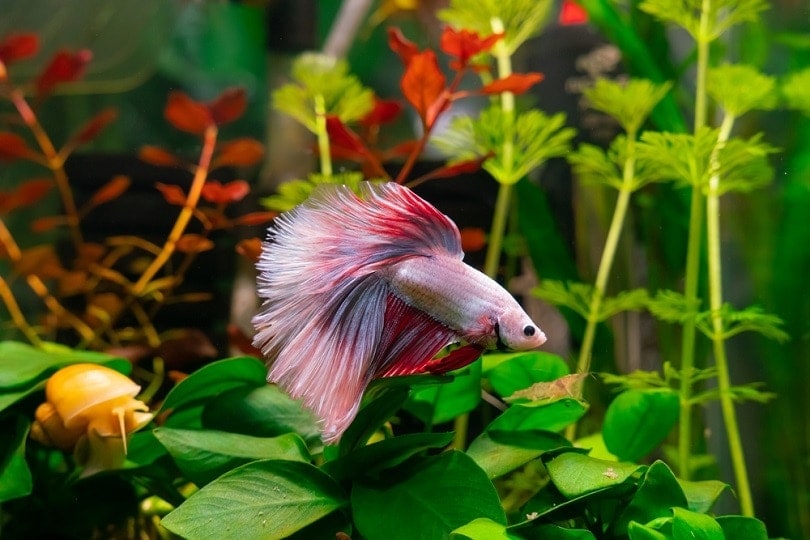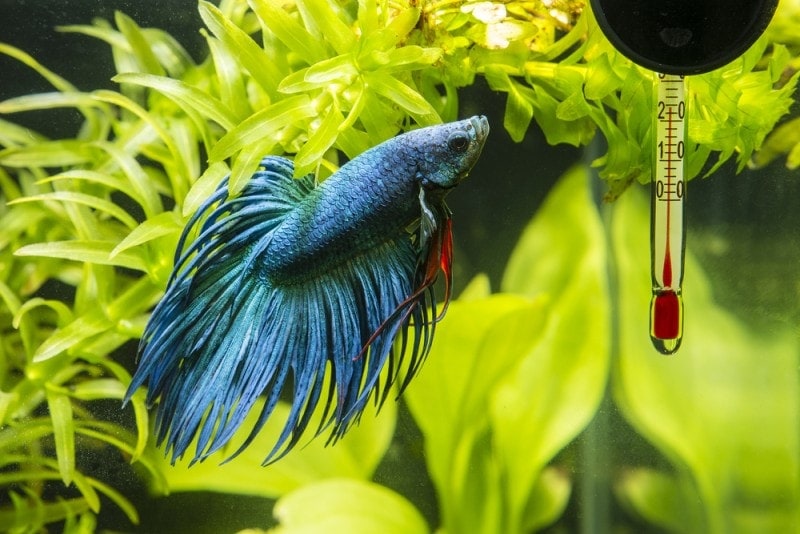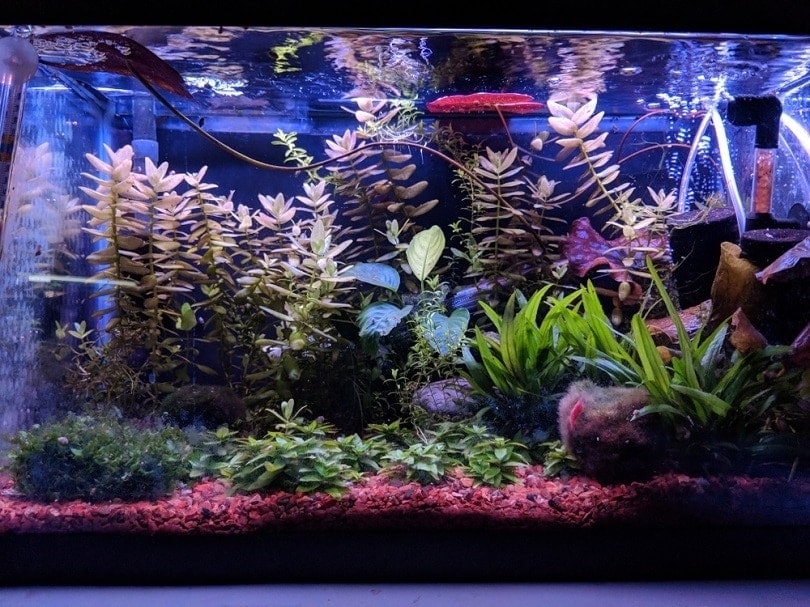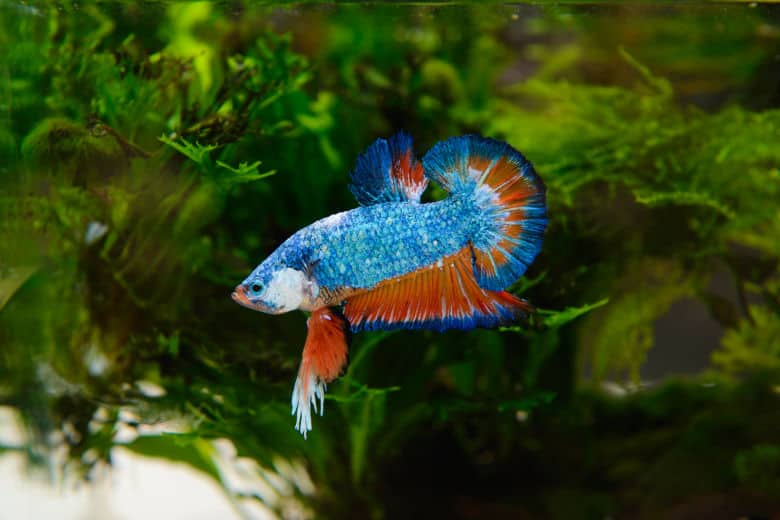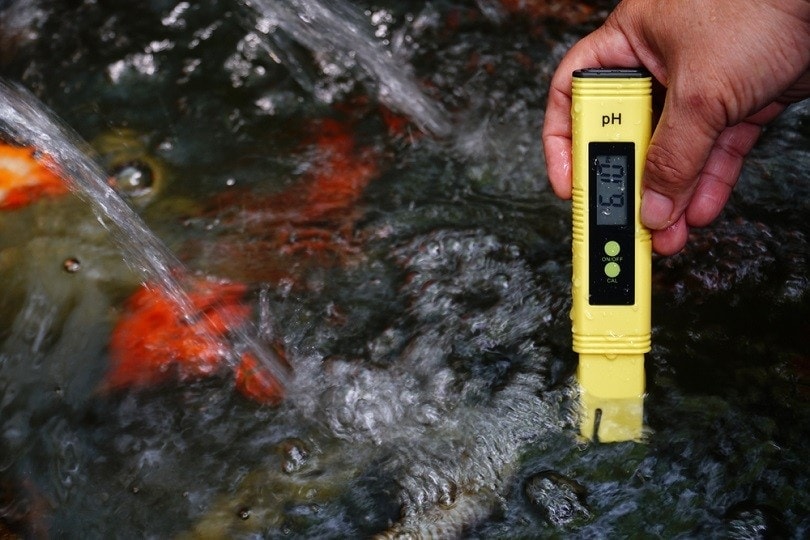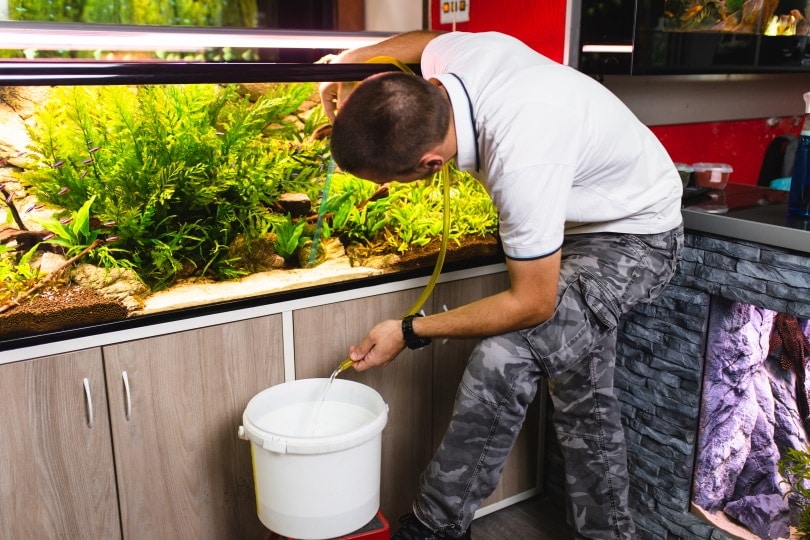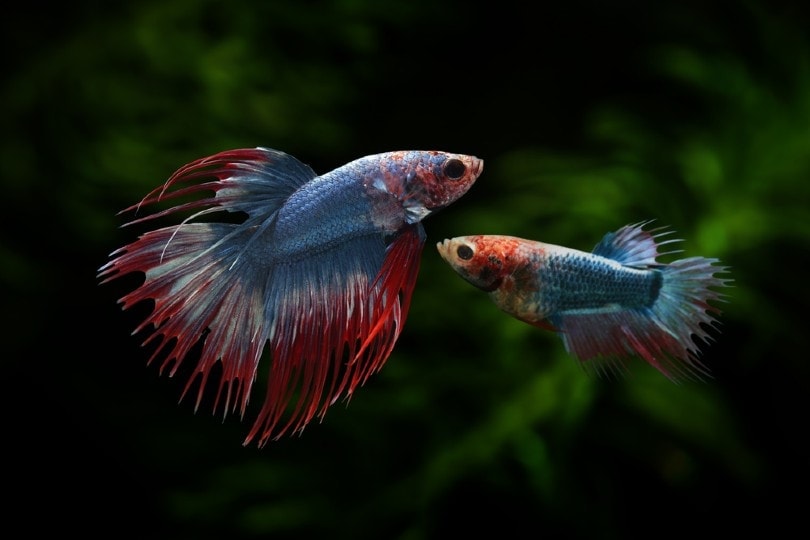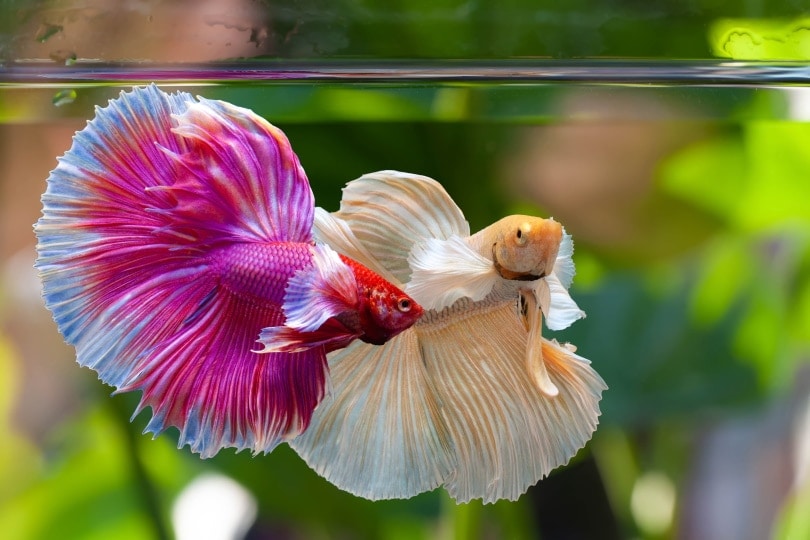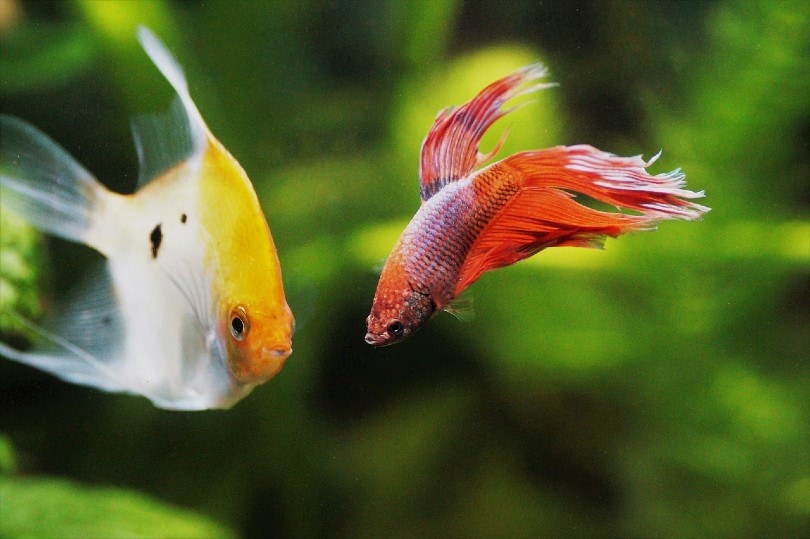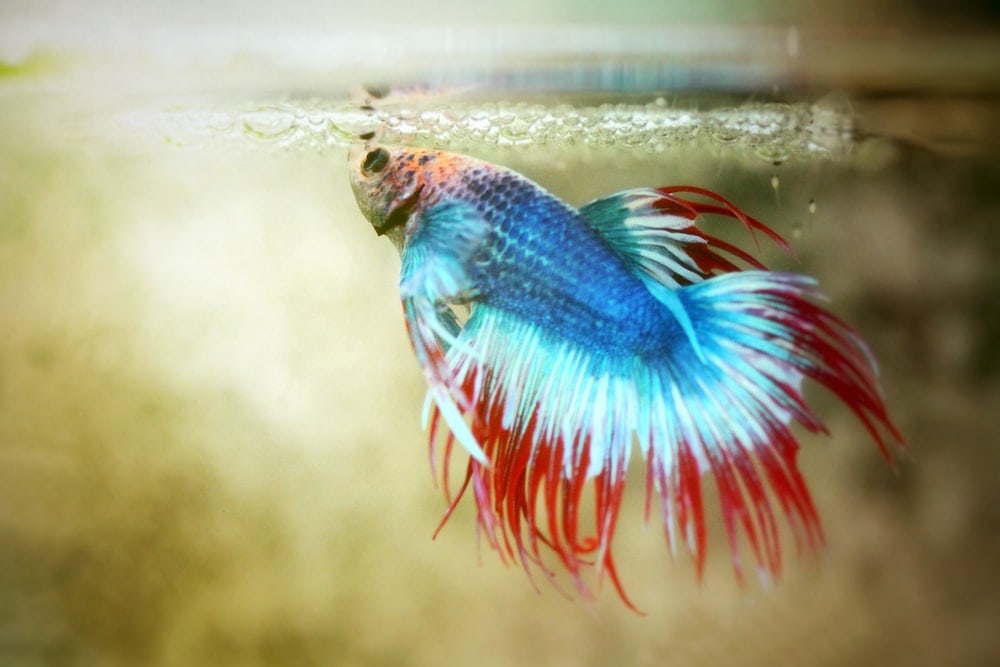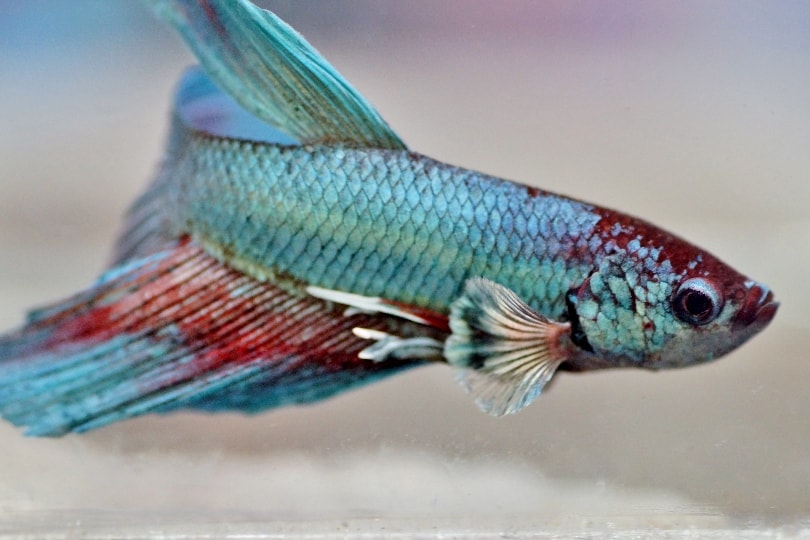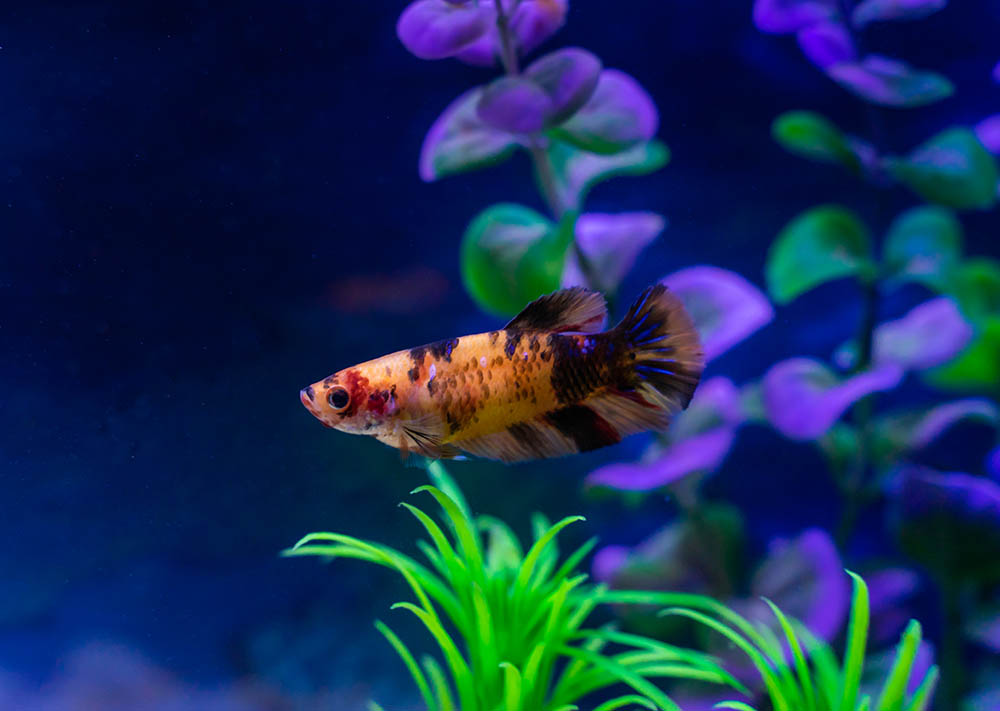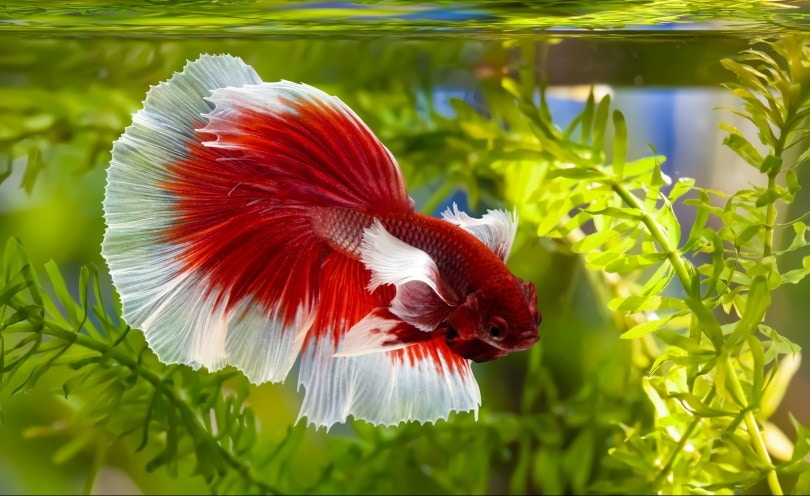Betta Fish Care Guide: Tank Setup, Diet, Cleaning & Tips

Updated on
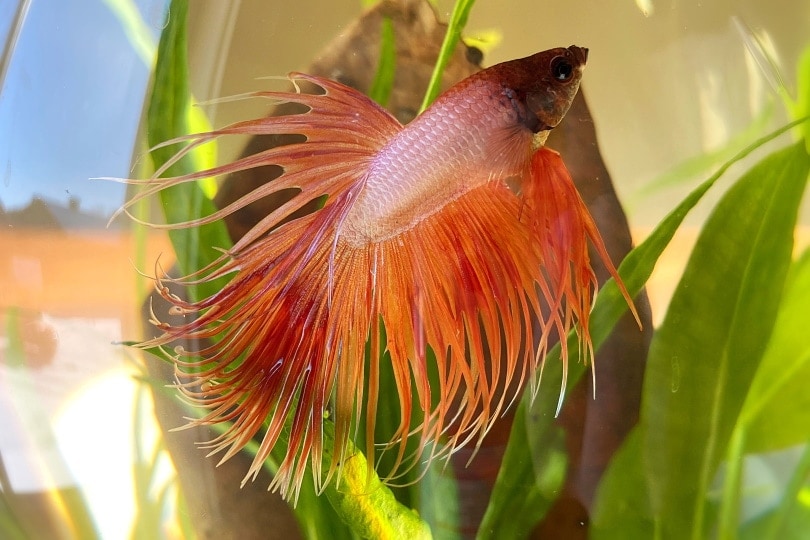
Welcome to the ultimate betta fish care guide! On this single page we cover everything you need to know to keep your betta happy, healthy, give them the best chance at a long and fulfilled life, and maximize your enjoyment of keeping this wonderful fish.
You will also find below a collection of links to other articles on this site that expand on each point in far more detail, if you want to dive deeper and learn much more. In these articles we cover in great depth everything from choosing the right tank, to how and what to feed them, water quality and temperature, to the best plants and tank mates to put with them.
However, following the info on this page alone will ensure you are doing everything right when it comes to caring for your betta.
OK, small talk over with, let’s get cracking with our guide on helping you get the most out of your betta-keeping experience. If you want a simple, easy-to-follow summary of all important betta care tips: Then please continue to read this page to the end. Everything is here, highly actionable, and is all you need.
Our advice: bookmark this page for easy reference as you begin your betta journey! You can trust us to steer you right—we’ve done a lot of “betta testing!”
Quick Facts About Betta Fish
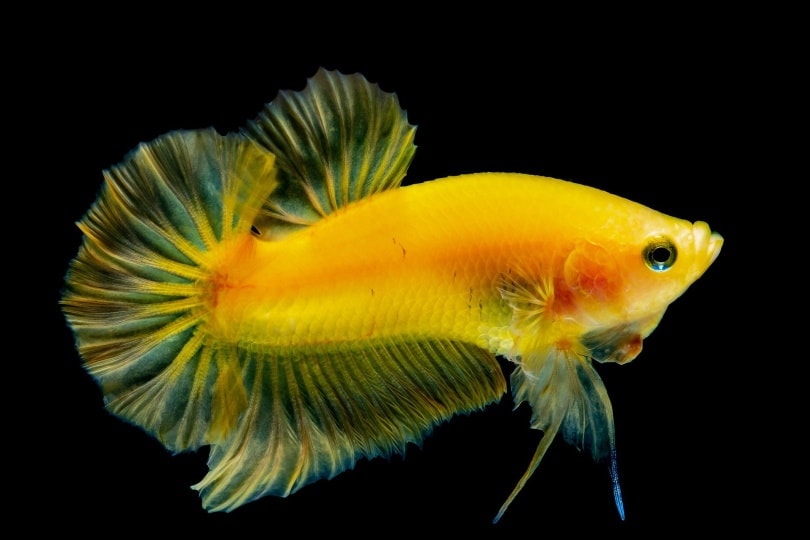
Betta fish are tropical freshwater fish that have a variety of color forms. They are arguably one of the most popular and widely available fish in the hobby. Whether this stems from their vivid coloration or quirky personalities, betta fish never fail to impress. They are typically seen in most pet stores and are popularly sold in plastic cups. This selling method leads people to believe betta fish can live in such small habitats permanently. Betta fishes are territorial and will fight with each other if they are in the same tank. Pet stores do not have the space to house each fish individually and this results in using plastic cups as a temporary holding space. Betta fish require as much space as possible for their true color potential to be reached. Alongside a desirable appearance, betta fish are well-loved for their unique personalities. Owners are quick to bond with their colorful friends. Bettas fall under the species of osphronemidae and share a close relation to paradise fish and gourami. Although betta fish are found abundantly in captivity, they are an endangered species in the wild. Betta fish have the potential to live a longer lifespan when kept in their optimal conditions. Betta fish in larger filtered setups will live a significantly longer lifespan than a betta in a cold and dirty vase. There are over 70 types of B. Splendens and they range in color, pattern, and form. Betta fish are easy to find. Every local fish store is stocking bettas to provide for their high demand by customers. Betta fish are inexpensive and can commonly be found for $1 to $3. If you choose to purchase your betta fish online or from a reputable breeder, you should expect to pay more. The price depends on their quality and rarity. Since most betta fish breeders work with rare variations, you should expect to pay between $5 to $10 for a quality betta. A betta fish purchased from an ethical breeder will live longer due to a better lineage. Fish-farmed bettas are usually raised in poor and highly stressful conditions before making it to the pet store. Betta fish are naturally territorial and aggressive. This means they should be house alone unless with compatible bottom-dwelling companions. Housing your betta fish with other territorial fish will cause unnecessary stress and constant exhaustion from constantly flaring. Two male bettas will generally fight till death or severe injury. Female betta fish can be housed together in a sorority, although this is not ideal unless you have a tank over 30 gallons. These fish are full of personality and express it from their tank. They can recognize their owners and follow them from side to side. A happy and healthy betta is fright and colorful with an active personality. Unhealthy bettas kept in small, unheated tanks will be dull and lethargic. Betta fish come in many different color morphs and patterns. They are well known for their bright colors and unique patterns unseen in other aquarium fish. Most color morphs are the result of careful expert breeding. All betta fish have a flattened, upturned mouth that resembles a permanent frown face. They have two black eyes on either side of their head on their elongated body. Their fins stretch out like a cloak through the water and size varies depending on the fish’s gender. Male betta fish have long and flowing fins, whereas a female has shorter and rounder fins. Extremely long-finned male bettas may tail bite if the current in the tank is too strong, leading to fin rot and disease. Betta fish originate from oxygen-deprived waters and have adapted to using their labyrinth organ. However, this does not mean they should be placed in an aeration-free home. A slow sponge or canister filter will cause a slow ripple with bubbles along the surface. These fish display colors like blues, reds, yellows, white, black, and morphs. Every betta fish is uniquely patterned. Betta fish come with a variety of tail varieties, namely the veil tail, crowntail, Halfmoon, or the short and neat versions called plakats. There is an uncommon form of betta called the elephant ear or dumbo betta. The name is given due to the large pectoral fins that give the appearance of ears. These forms are typically available from breeders. Color morphs consist of the standard blue, black orchid, red, rose petal, yellow, white, green mustard gas, and purple betta fish. Most exotic colors are not commonly sold in pet stores. Blue, red, white, and black bettas are common and mass-produced in betta breeding farms. There’s so much more to keeping fish than just the fish themselves. Half the fun is choosing all the gear! Let’s look at some of the equipment you’ll need to give your betta the best possible home. Before you choose your fish, you first have to prepare a proper home for it. You don’t want to bring home a new betta and then not have somewhere for it to live right away. The very first thing you must get right when taking care of betta fish is to get an adequately sized aquarium. Let’s say that again, shall we? An aquarium. They do not belong in cups or bowls. They need room to swim, and the same controlled conditions all aquarium fish require to truly thrive. You could go with an aquarium as small as 2.5 gallons, but we recommend at least a 5-gallon aquarium. A larger tank is easier to cycle and maintain optimal temperature, pH, and so on. The extra space also allows your betta to move about more freely and gives you room to accessorize your tank with ornaments and plants. These are great for helping your fish feel safe and entertained. You should also think about whether you might choose to add other fish and aquatic creatures to your betta tank. Bettas can live happily with a number of community fish, but you must have a tank large enough to accommodate everyone. Follow the “one inch of fish per gallon of water” guideline, and give some thought as to how many fish, and what varieties, you might want in the future. Finally, always choose an aquarium with a lid. Despite their flashy appearance, bettas are built for more than show! They are agile and have been known to leap right out of tanks. To save yours from an ill-advised attempt to look for a new home, be sure to have a tight-fitting lid on your aquarium. Substrate is the stuff that lines the bottom of a tank. Typically, it’s some sort of gravel or river stones, though sand is sometimes used, and marbles are a fun and surprisingly practical option for smaller tanks. Not only is substrate decorative, but it’s also functional, as it traps debris and acts as a basic filter. It’s also useful for anchoring plants and decorations. But do you need substrate for a betta tank? Well, no. They can get by just fine without anything lining the bottom of their aquarium. They don’t forage, so they won’t miss out on the fun of shoving rocks and sand around looking for food. However, if you plan to have live plants, or other kinds of fish who do forage, bottom feed, or burrow, you will want something lining the bottom of the tank. Plus, the substrate provides a home for beneficial bacteria. And besides, it just looks better, don’t you think? Whatever type of substrate you choose, just be sure it’s smooth. Bettas don’t go to the bottom often, but if they do, sharp and jagged edges can damage their beautiful fins. As mentioned earlier, a bowl or cup of still water is not a suitable environment for a betta. The water must be pumped through a filtration system to keep it clean and healthy. It is very important to choose a filter that creates a gentle circulation of water. Bettas are not strong swimmers, their tails being so large and flimsy, and they won’t last long in a strong current, which can lead to stress. Water temperature is one of the most important elements of proper betta fish care. They are tropical fish, native to some of the warmest parts of Southeast Asia. They are therefore designed by nature to live in water that’s about 76 to 81 degrees Fahrenheit (or 24 to 27 Celsius). To maintain this temperature, most of us will need to install a heater. Aquarium heaters are easy to install, and if you’re worried about aesthetics, you’ll find they’re equally easy to conceal with plants or other decorations. You’ll also want to keep an aquarium thermometer in your water so you can keep an eye on temperature fluctuations. To help your heater do its job more efficiently, think carefully about tank placement. Try to avoid placing it near radiators, fireplaces, stoves, heaters, or vents that might blow cold or warm air on the tank, and stay clear of windows and direct sunlight. Simply filling up a tank with your local tap water is not healthy for your fish, even if you keep it at the right temperature. Most municipal tap water contains additives that keep us safe but can harm your fish. There are all kinds of water conditioners available to transform tap water into acceptable aquarium water. These simple-to-use products perform necessary tasks like removing chlorine. Also, be sure to pick up a test kit for your water. It’s essential to be able to keep tabs on your pH, and ammonia, nitrate, and nitrite levels on your own. Regular testing will allow you to get on top of any water quality issues that may arise before they become a health problem for your fish. A betta tank requires a pH level between 6.0 and 7.5. Since a pH level of 7.0 is neutral, that means the water can range from slightly acidic to very slightly alkaline. Water care for your betta is a BIG topic, and since this guide is already into many thousands of words I don’t want to go too in-depth on it here. Instead, check out this guide to ph levels for a betta, which is extensive, easy to follow, and will have you up to speed in no time. If someone forced you to leave your light on all day and all night, you’d get pretty cranky about it before long! The same goes for your betta; they need a proper day/night cycle that mimics what they’re used to in nature. It’s possible the natural lighting in your room may be sufficient, but you’ll probably want to augment that with artificial lighting. This gives you total control over the situation—ideal if you live somewhere that’s cloudy a lot, or if you live in the far north or south, where the amount of daylight in 24 hours shifts dramatically during the year. Artificial light will also make the colors on your fish and décor “pop,” making everything look amazing. Bettas like a day/night cycle that’s similar to what humans and other diurnal creatures do. Make a point of turning on the light in the morning, and turning it off when you go to bed. Hooking your lighting up to a timer can make it a “set it and forget it” process. While they are undoubtedly aggressive fish, at least towards each other, bettas still love to have places to hide and rest their weary fins. Even if you’re going with a small tank, you should make sure to provide some nooks and crannies for your betta to hole up in, and horizontal surfaces for resting on. Any aquarium store will offer a ton of options for your tank. Choose from pre-formed caves, little buildings, shipwrecks – whatever strikes your fancy! Plants, both real and artificial, rocks, and natural driftwood are also great for providing some cover. Choose your décor carefully, however. Sharp edges can damage a betta’s delicate fins, so pick items with rounded edges and smooth surfaces. For plants, live is best, but if you’re going with artificial select soft, silky plants and not ones made out of hard plastic. Now that you’ve got all the right stuff to create the perfect home for your betta, it’s time to set it all up! Let’s walk through the steps you’ll need to take to ensure a smooth start-up. The first step is to clean your tank. This is equally important whether you’re recycling a used one, or you’ve bought one brand-new. You want to be sure the tank is free of contaminants before you add anything to it. Cleaning a new tank is easy since it has never had anything living inside of it. All you need to do is take a damp cloth and thoroughly wipe down all the interior surfaces and the rim of the tank. You should also wipe the inside of the lid and anything that will go into the water, which will be the heater, filter intake, any air hoses, and decorations. Warning! Under no circumstances should you ever use soap, chemical cleaners, or detergents inside your aquarium! Even trace amounts of these products can be harmful to your fish if left behind. Even if you buy bagged substrate, it still needs to be thoroughly rinsed before you put it in your tank. For gravel or marbles, your best bet is to rinse in a clean colander, strainer, or sieve under hot water in the kitchen or laundry room sink. Rinse thoroughly and repeatedly until the substrate is good and clean before carefully spreading it across the bottom of your aquarium. If you can dedicate a strainer to this purpose, so much the better. You don’t ever want to risk getting cleaning chemicals mixed into your tank water. If you’re using sand, of course, it’s too fine for a colander. You’ll need to patiently rinse it in a bucket or similar container and carefully pour out the water after the sand settles. Set up the filter, so you’re all ready to keep the water as clean as can be right from the start. Every filter is a little different, so you’ll need to consult the manufacturer’s instructions for specifics. If you find them hard to follow (and you won’t be the first person!), try searching for a YouTube video about your specific filtration system. If you’d rather read your way to success, we highly recommend checking out this comprehensive article on setting up five common aquarium filter types. We’ll wait here while you check it out! Remember—you should NEVER turn on your filter until the tank is full of water! Running a filtration system dry is a sure way to destroy the pump and ruin your day. Betta must be kept in 76F to 81F water. Before anything else goes into your aquarium, it’s time to put in the heater. It’s much easier to do this before adding decorations since you’ll probably want to try and conceal the heater with your plants, rocks, castles, and whatever else you’ve got. Install your heater wherever it’s most convenient, and probably least visible. This usually means placing it in one of the back corners. Make sure the cord doesn’t prevent the cover from closing properly. As with the filter, do NOT turn on the heater until the tank is full of water. Running a heater without water may damage the heating element, and could cause the glass casing to explode. Now you’re ready to get artistic! Decorating a tank is a lot of fun, and it’s part of what makes each aquarium unique. Will you go for a natural look, or something more whimsical? (The bubbling treasure chest is a classic!) As with the substrate, be sure to thoroughly rinse all new or reused decorations before positioning them in the tank. DO NOT USE SOAP! Though it may be tempting to buy every cool or cute decoration you see, be sure not to overcrowd your tank. Your betta needs room to move freely about its home, and having too many things in the water will limit its space. Live plants that root in the substrate should be added after some of the water is already in the tank, so the roots stay moist during the rest of the setup. In my experience, artificial plants are the easiest to add after the tank is full. This way you can more easily control how the leaves float and ensure they stay anchored. Everything that goes in the water is in place (except the fish!), so it’s time to fill up the tank. For most of us, our source of water for the aquarium is the closest tap. Generally, that means a municipal water supply that’s cleaned at a filtration plant before being pumped to local residents. Municipal water is treated to keep us healthy and safe, which means it’s full of chemicals like fluoride and chlorine. These additives are not good for fish, however! Purchase a water conditioner solution to purify your tap water. There are betta-specific conditioners you can buy, but any freshwater aquarium water conditioner will do. Follow the manufacturer’s instructions to properly treat your water before adding it to the tank. If you use well water, you should still condition it to remove run-off pesticides and unwanted trace heavy metals. Do NOT use distilled water as it has been stripped of the minerals that your fish need to stay healthy. Now that the water is conditioned, you can pour it into the tank. Be careful not to disturb the substrate with a blast of water! Add the water slowly, or pour it directly onto any large rocks or decorations to break up the flow. As we mentioned earlier, bettas do have the ability to jump out of the water and potentially go over the wall. To prevent an escape, make sure the tank has an adequately fitted lid. Even the smallest opening is a potential escape hatch (or a death trap, depending on your point of view), so make sure they’re sealed. Access flaps should either snap closed or should be locked or weighted down in some manner. I personally had a particularly determined loach blast its way out of an aquarium through a closed filter access! Now that you’ve placed everything in your tank, including the water, it’s time to add your betta, right? Wrong! There’s still one last step to take: cycling. Despite having added the chemicals and cleaners needed to make your aquarium water safe for fish, the tank needs to establish a nitrogen cycle before you add any residents. We’ll be right up front with you: the fishless cycling process could take weeks to complete, so don’t rush out and choose your betta just yet. So, what does it mean to cycle your tank? Maybe you’ve heard of the nitrogen cycle. It’s the process by which bacteria in the tank convert the ammonia produced by fish waste into less-harmful nitrites. More bacteria then turn nitrites into nitrates, which are mostly harmless. That’s an over-simplified explanation of a very important process. The problem is, and you may have figured this out already, a clean, new tank doesn’t have any bacteria in it. It will, however, have fish waste in it soon after you add your fish. Cycling the tank kickstarts the nitrogen cycle before you add fish, so the natural cleaning process is already rolling for your new friends. So how do you begin the cycle? The easiest way is to add filter media from an established tank. If you have an old tank, you can move it over. Or, you can take some from a friend whose aquarium care is trustworthy (i.e., free of pathogens). Failing that, you could just borrow the filter and squeeze it out into your water. Either way, the healthy bacteria will soon establish themselves in your tank. You could also add ammonia to the tank and wait for bacteria to find it, or start adding fish food and letting it rot. Give the cycle time to get rolling and then start testing your water. Test kits (strips or drops) are easy to use and will let you know the nitrite and nitrate levels in your tank. Once the cycle is established, you’re ready to move in your new betta! The nitrogen cycle is something every aquarist should understand thoroughly. For a more complete explanation, take a few minutes to read our comprehensive, step-by-step guide to cycling your fish tank. Your tank is all prepped and ready—now it’s time to choose your betta! Here is some important information to help you make the best decision for you. The classic betta tank typically houses a single male. As is the case in much of the animal kingdom, males tend to be flashier in color and ornamentation than females. This makes them a popular choice for aquarists. Of course, there’s absolutely no reason you can’t choose a female betta for your tank. Some females are nearly equal to males in appearance. Ultimately, the choice is entirely up to you. If you’ve decided to get a male betta, keep in mind that you cannot have a second betta in the same tank. There’s a reason they are also known as the Siamese fighting fish, because of their very territorial and aggressive nature when it comes to sharing space with other bettas. They just will not do it peacefully. Two male bettas in the same tank will absolutely fight with each other, possibly with fatal results. Housing a male and a female together may not yield any better results. Males and females do not bond as pairs and only come together when it’s time to mate. So for the safety of your bettas, males must be kept separate from other bettas. If you really feel the need to have multiple bettas in the same tank, you can have a group of females. They will establish a pecking order, and once that’s done, there shouldn’t be any unrest. Understand, though, that they won’t move about in a group—they’ll pretty much spend their time avoiding each other. Bettas have no natural desire to hang out together, so there seems no reason to force the situation on them. It’s best to go into this knowing you’ll have just one betta in your tank. Many aquarists, especially those new to the hobby, have experienced the frustration and even heartbreak of bringing home a carefully chosen fish, only to have it die shortly thereafter. This commonly happens when aquarium fish are kept in huge groups in small tanks at the store. For betta, this is more likely the result of spending too long in a tiny enclosure. Knowing what signs to look for will make it much more likely you’ll pick a healthy betta to bring home. These include: Avoid bringing home betta that shows these signs: Now that the tank is ready and you’ve brought home your fish, it’s time to introduce him or her to their new digs. As with most aspects of fish keeping, this final step must be approached with caution and patience. Try to bring it home as gently as you can, avoiding sudden jostles and changes in light quality. If you can keep it in the dark, that’s the best option. Once you’re home, just dumping a new betta in a tank of water can shock the poor fish due to the difference in temperature. The betta has become accustomed to the water in its previous enclosure, which it’s still in whether you brought it home in a cup or a bag. Also, if there are any contaminants in the store water, you’ll be adding them to your tank. The simplest way to acclimate your new fish is the floating bag method. Here it is in a nutshell: To learn more about acclimating a new fish, including alternative methods, have a look at our comprehensive article on safely introducing a new fish to an aquarium. It’s great stuff to know, whether this is your first fish or your fiftieth. Betta fish make poor tankmates. They are both aggressive and territorial, which makes them undesirable for community tanks. Luckily, there are a few exceptions to tankmates for betta fish. Which include small peaceful tropical fish. Fish that fin-nip or chase should be avoided. It is best to choose compatible species with your betta. If you plan to keep other types of fish with your betta, the tank should be considered large for the stocking amount. Some fish may grow too large to be housed with bettas and they may attempt to swallow the betta. Bettas are also able to consume, chase and nip other fish. Creating a stress-free environment for all fish involved is the best option. We’ve got this fun topic covered in more detail in our guide to choosing compatible tank mates for your betta! You’ve provided a safe environment and clean water. Next on the basic list of necessities to take care of betta fish is appropriate, healthy food. What do betta fish eat? Are they herbivores or carnivores? And do they feed at the surface or the bottom? The answers are here. Bettas are carnivorous surface feeders. That means they’ll rise to the top to nibble on meat (and other food), but they won’t be scavenging anything off the bottom. Bettas, like cats and many children, can be fussy eaters. It may take you a few tries to find something he or she really enjoys. The best-case scenario is finding a few things yours likes so you can provide a varied diet. Foods they typically go for include bloodworms, brine shrimp, mosquito larvae, and other freeze-dried proteins. There are also many excellent pellets to choose from, formulated especially for bettas. Generic, flake-style fish food does not provide the nutrition bettas need. If you use flakes, make sure they are specifically made for bettas. Your betta can’t tell you if it’s hungry, so it’s essential to establish a schedule and stick to it. Routines are good for fish, and for fish keepers! If it’s easiest for you, you can simply feed your betta once a day. If you go with pellets, 3 to 4 will be sufficient. Treats between feedings are ok, too, as long as they are in moderation, and don’t do it every day. Feeding twice a day is fine, but reduce the number of pellets to 2 or 3. Overfeeding can cause all kinds of distress to your betta, and it can foul up the tank water. Be sure whatever you’re putting in the tank is being consumed entirely to avoid food waste accumulation. A stressed betta may lose its appetite, but there’s no need to panic. An otherwise healthy specimen can go as long as two weeks without starving to death. That also means it’s perfectly safe to go away for a few days and not feed your betta. Of course, using an automated fish feeder is a simple way around this problem. Maintaining your betta tank is a never-ending process. That’s ok, though—part of the fun of fish keeping is being hands-on with it. This also allows you plenty of time to interact with your fish and enables you to keep tabs on the health of your fish, and the condition of its home. Here are the key tasks you’ll need to perform, broken down into daily, weekly, and monthly chores: Well, that’s a heck of a lot of information to take in! To help you keep it all straight, and for a handy reference guide, refer to our easy-to-follow Betta Fish Care 101 Infographic! All the basic facts about bettas and how to provide proper care for them are here. You might even want to print it out and hang it up somewhere! It is tricky to successfully breed betta fish. It should only be attempted by professional and ethical breeders. Due to betta fishes’ territorial nature, fights can break out at any moment. To avoid potential injury to your breeding pair, you need to ensure both are ready to breed and the tank has lots of places to hide. A male betta will build a bubble nest on the surface of the water, typically under a leaf. The bubble nest will resemble thick, minuscule bubbles that group together. The nest is what attracts the female to the male, and they will take part in a breeding ritual. This ritual resembles a circular dance. The female will deposit eggs that the male will carefully place in the nest once they are fertilized. After this process, the female should be removed immediately. The male betta will protect the nest and pick up any fallen eggs. The female plays no role in parental care. And there you have it! All the vital information you need on how to care for betta fish. Owning betta can be a very rewarding experience, especially if you give it everything it needs to flourish. Enjoy your new companion! Be sure to check out our other articles below for even more details on betta care, and getting the most out of aquarium ownership. If you still can’t find what you’re looking for, give us a shout, and we’ll do our best to help you out. Thanks for taking the plunge with us today, and we’ll see you again soon! Happy fish keeping! More Betta Fish Guides: Featured image credit: Arvilla, Shutterstock
Species Name:
Betta splendens
Family:
Osphronemidae
Care Level:
Easy to moderate
Temperature:
25°C to 30°C
Temperament:
Aggressive
Color Form:
Red, blue, mustard, black, white, orange, pink, rust, ruby, grey with different colors, shapes, and patterns
Lifespan:
2 to 5 years
Size:
3 inches
Diet:
Carnivore
Minimum Tank Size:
5 gallons
Tank Set-Up:
Freshwater: Plants with flat, upturned leaves
Compatibility:
Singular or with small bottom-dwellers
Betta Fish Overview
How Much Do Betta Fish Cost?
Typical Behavior & Temperament
Appearance & Varieties
Getting The Right Tank, Equipment, and Accessories for Your Betta
Choosing the Right Tank
Substrate Choices
Does My Betta Tank Need a Filter? What Type Should I Choose?
Water Temperature, Heaters, and Thermometers
Water Quality and Parameters
Lighting Needs
Plants and Decorations
Setting Up Your Tank for Optimal Betta Fish Care
Initial Tank Preparation
Adding your Substrate
Installing the Filter
Adding a heater
Adding Plants and Decorations
Adding Water and Treating It for Safety
What if I Have Well Water?
Make Sure You To Keep A Lid On It!
Cycling Your Tank (aka Fishless Cycling)
Starting the cycle without fish
Buying and Adding Your Betta to the Tank
Should I Choose a Male or Female Betta?
How Many Bettas Can I Keep in One Tank?
Making Sure You Pick Healthy Fish
Adding your Betta to the Tank
Do Betta Fish Make Good Tank Mates?
Food and Feeding for the Best Betta Fish Care
What do They Eat?
How Often Should You Feed A Betta?
Betta Tank Maintenance – Daily, Weekly, and Monthly Tasks
Daily Tasks
Weekly tasks
Monthly tasks
Infographic: How to Take Care of a Betta
Breeding
Final Thoughts


